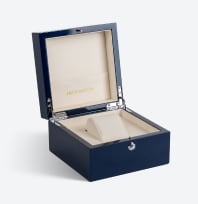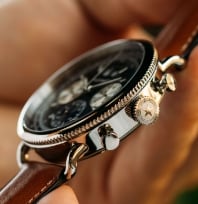Watch crystal is a general term that refers to the transparent glass material that covers the face of a watch. It is designed to shield the watch from the elements and provide a polished look to your watch. Watch faces on the market are not actually made from crystal, but instead made of a variety of manufactured crystalline glass-like materials. Watchmakers worldwide only use three types of crystal to cover the watch’s face.
Which material is best?
The best material can be extremely subjective to the type of watch, the conditions in which the watch will be exposed to, and the wearer’s preference. There are three main types of the watch crystal. Each has its pros and cons and quite literally strengths and weaknesses. Learning the lingo and the different attributes of each type will help the new watch buyer and the aficionado alike in knowing what to expect from their watch, how they can repair it, or if they have to replace a crystal when damaged.
At Jack Mason, we use nothing less than mineral crystal, although most of our watches use sapphire crystals. We have chosen each watch face carefully for each individual watch’s needs and structure, using mineral where strength is a more critical factor, like in several of our Nautical watches built to withstand depths, harsh conditions, and using Sapphire where luxury and utility meet. Like in our highest rated watch, our Dark Green Dial With Recycled Plastic Strap Solar Watch.
Sapphire Crystal
The highest standard for watch crystals these days is sapphire crystal. It was originally created by a French chemist who went by the name of Auguste Verneuil, who made glass sheets of it by collecting and superheating aluminum oxide powder while placing it under intense pressure as well. He then heated the crystal to eliminate its internal stresses as it can cause weakness, it then enters the final processing stage where it is processed into sheets, and voila, synthetic sapphire glass.
Some key traits:
- Most durable, hardest crystal material on the market.
- It is a transparent, crystallized aluminum oxide produced in a lab.
- It is scratch-resistant apart from diamonds.
- It stays bright and uncloudy for years to come.
- It has the most shine and is the most reflective.
Sapphire crystal is beautiful and extremely scratch-resistant. It adds a lovely mirrored shimmer to the case of your watch, highlighting the components within. However, it should be noted that sapphire glass is capable of shattering or cracking and is not always suitable for extreme pressure and water abound conditions.
To give you a good idea of what these watches are like, take a look at our top three Jack Mason picks with Sapphire Crystal:
- Solar Watch 42mm - Dark Green Dial With Recycled Plastic Strap
- Seamount Automatic 42mm Black Dial With Stainless Steel Bracelet
- Halyard GMC 42mm White Dial with Stainless Steel Bracelet
Mineral Crystal
Mineral crystal glass is the most common glass you’ll find on a watch.
Mineral crystal glass is made from silica and is manufactured using regular tempered glass. This tempering process makes the mineral crystal much more scratch-resistant and able to handle great depths and pressure. Not to mention, the manufacturing of mineral crystal costs are still relatively low. These factors combined to aid in its frequent use as watch glass.
However, mineral crystal is not completely scratch-resistant, and in its lifetime, it is likely to hold a few scratches. If this happens, you can, for the most part, buff out these scratches yourself. If you are unable to remove the scratches with basic buffing and polishing, you can send it to the watch manufacturer for inspection. The manufacturer will be able to tell you whether a new glass piece should be installed or if the scratch could be removed with further buffing and polishing.
Some key traits:
- Less likely to break over sapphire.
- Made from silica similar to glass fitted in windows.
- More scratch resistant than acrylic glass, but way less than sapphire and can’t polish or buff out scratches, higher impact resistance is less reflective than sapphire, making the watch more comfortable to read.
Mineral Crystal glass is often coated in an Anti-Reflective Coating. This is sometimes referred to as an AR coating or anti-glare coating. Some brands include this coating as standard to help boost readability in harsh lighting conditions. It can enhance the watch face’s visibility while telling time and also reduce the strain on your eyes. This coating can make your watch more aesthetically pleasing as it will effectively remove any glare.
Acrylic Crystal
Acrylic crystal is considered to be the bottom of the market. This classification is mostly due to the affordability and availability of the product, but also due to stigmas set in place by classic watch enthusiasts. Watches that use acrylic typically come with a lower price tag, though this is not always the case. An exception to the rule is that some diving watches use an acrylic crystal to help withstand a certain depth of pressure.
Some key traits:
- More transparent than sapphire
- Sparkle over mirror
- Pretty much fingerprint resistant
- Easily polishable to remove and surface scratches
- More flexible so it can withstand higher impacts - i.e., use in diving watches and military field watches
Here are Jack Mason’s top three Mineral Crystal watches that boast strength, durability, and style:
- Halyard White Dial with Tan Leather Strap
- Seamount Blue Dial With Stainless Steel Bracelet
- Pursuit Navy Dial With Brown Leather Strap
Variety, variety, variety!
Nowadays, watches aren’t just manufactured to be instruments. Watches are designed to be an investment and complement the wearer’s lifestyle, lifestyle, and activities. They are created with value in mind. Luxury materials are preferred, and with more styles of watches on the market, you are sure to find the perfect one to suit your needs, quality desires, and your style.
Sources:
www.vondoren.com/single-post/Watch-glasses-Insights-and-Tips
https://www.firstclasswatches.co.uk/blog/2018/04/the-complete-guide-to-watch-glass/
https://www.superwatches.com/your-ultimate-guide-to-watch-glass/









